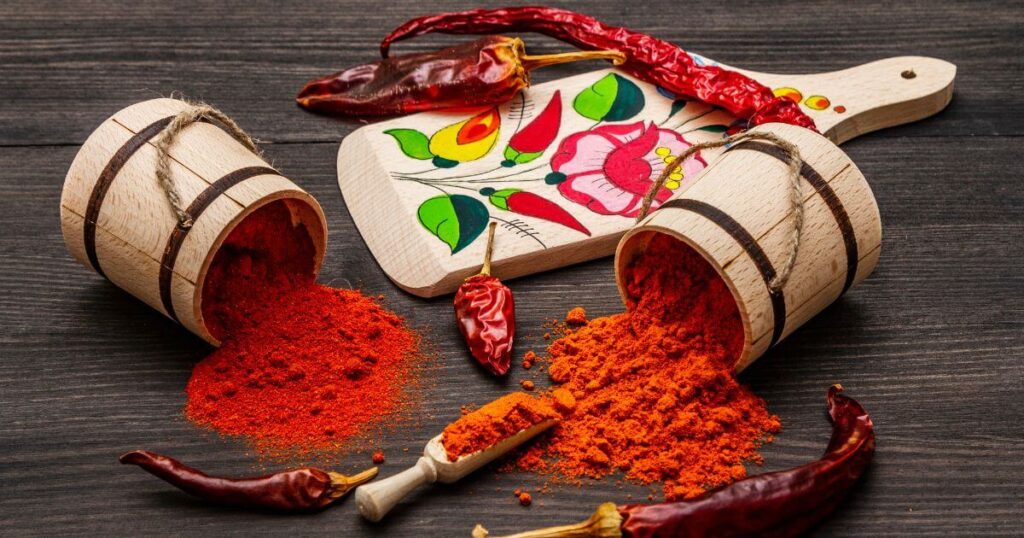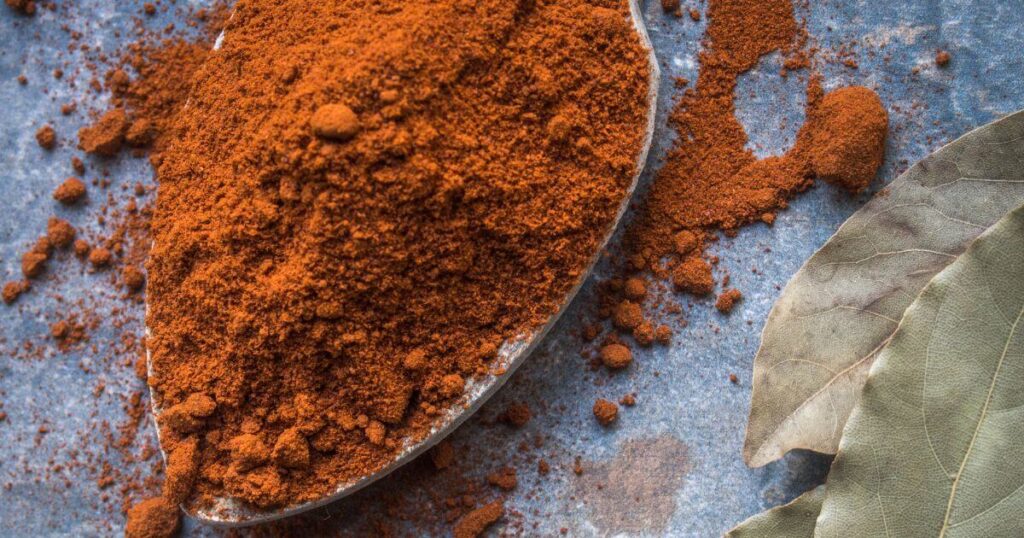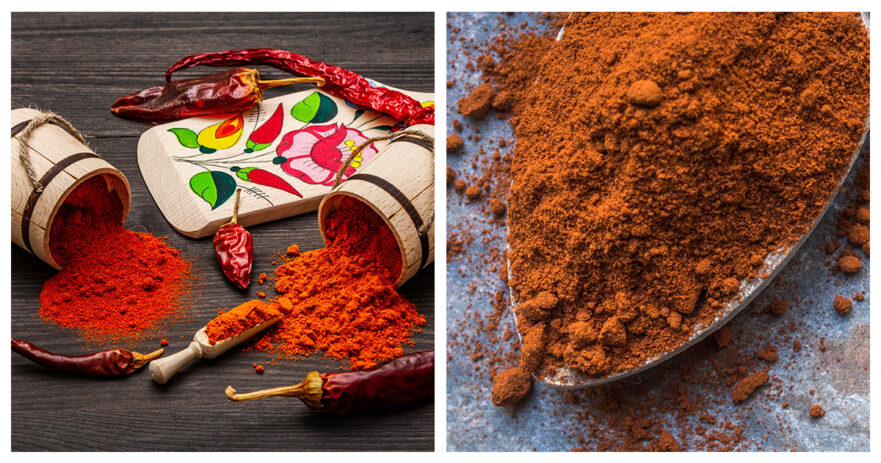Paprika takes a prominent place in the world of spices, painting dishes with its vibrant hue and infusing them with a balance of sweetness, bitterness, and heat. Today, we spotlight two renowned variants of this spice: Hungarian and Spanish Paprika. Both types have distinctive niches in the culinary world owing to their unique characteristics. Let’s explore the distinct features of Hungarian and Spanish Paprika, comparing their flavors, heat, and culinary uses.
Table of contents
What is Hungarian Paprika?

Hungarian Paprika hails from Hungary, where it is vital to local cuisine. Its color varies from light orange-red to deep blood red, reflecting its range of flavors. The heat levels of Hungarian Paprika range from sweet and mild to hot, measuring between 100 to 15,000 SHU on the Scoville scale, but some extra hot Paprika can reach 60,000 SHU.
Beyond its broad range of heat levels, Hungarian Paprika has eight distinct varieties, each with unique qualities. The spectrum begins with ‘Különleges,’ boasting a vibrant red hue and refined flavor. ‘Csípősmentes Csemege’ and ‘Csemege’ follow, rich and aromatic, with the former milder. ‘Édesnemes’ is recognized for its brilliant color and sweetness, while ‘Félédes’ offers a blend of sweetness with a touch of heat. ‘Rózsa’ brings a moderately spicy warmth. ‘Csípős Csemege’ takes it up a notch with increased spiciness, and finally, ‘Erős’ crowns the scale as the most piquant. Each type contributes to the depth and breadth of flavors within Hungarian gastronomy.
The sweet variants impart a pleasant warmth and vibrant color without fiery heat, making them perfect for dishes like goulash, chicken paprikash, and soups. The hot variant adds a fiery kick to spice dishes needing more zing, like the traditional smoked, hot sausage, the Hungarian kolbász.
Furthermore, the Hungarian plains’ unique climate and soil shape Paprika’s distinctive qualities. From sun-drenched summers to fertile, mineral-rich soil, each element contributes to the cultivation of this iconic spice.
What is Spanish Paprika?

Spanish Paprika, or Pimentón, hails from Spain. It’s a fundamental ingredient in the culinary landscape. Its color ranges from bright, fiery red to deep, smoky burgundy, reflecting its flavor. In terms of heat, it can range from sweet and mild to hot, rated from 100 to 4,500 SHU on the Scoville scale.
Spanish Paprika’s charm lies in its depth and flavor complexity. It is available in ‘Dulce’ (sweet), ‘Agridulce’ (bittersweet), and ‘Picante’ (hot) varieties. Additionally, each of these comes in a smoked variant, imparting a distinct smoky aroma and flavor. Spanish Paprika is essential in dishes like paella, fabada, and myriad tapas, and the smoked versions enhance the flavors of barbecued meats and robust stews.
Key Paprika-producing regions in Spain, like La Vera and Murcia, are under Denomination of Origin (D.O.) control to ensure that traditional methods of growing, smoking, and grinding peppers are followed meticulously.
The method of drying peppers sets Spanish Paprika apart from its counterparts. The Spanish method involves slow-smoking the peppers over oak. This process imbues the Paprika with its characteristic smoky flavor and locks in its vibrant color and aroma. As such, preparing Spanish Paprika becomes a ceremonial celebration of the country’s rich heritage and a testament to the artistry passed down through generations. This adherence to tradition underscores the importance of Spanish Paprika in the national cuisine and enhances the authenticity of dishes.
Similarities between Hungarian and Spanish Paprika
The primary similarity between Hungarian and Spanish Paprika is their range of heat and flavors. From sweet and mild to hot, both types cater to a broad spectrum of tastes and applications.
Hungarian and Spanish Paprika are essential to their respective cuisines, providing distinctive flavors and colors to traditional dishes. They’re both versatile, fitting into various recipes where they impart a depth of flavor.
Another shared trait is their vibrant red color, brightening dishes and making them visually appealing. Whether the deep red of Spanish Paprika or the brilliant hue of the Hungarian variety, their colors make each dish visually enticing, enhancing the overall experience.
Hungarian and Spanish Paprika are designated products of controlled origin, meaning they are grown, harvested, and processed within specific regions following traditional practices. This control ensures the quality and authenticity of Paprika, contributing to their distinct characteristics.
Furthermore, Hungarian and Spanish Paprika have been internationally recognized for their superior quality, winning the hearts of chefs and home cooks worldwide. These Paprikas, each carrying the signature tastes of their native soils, have transcended borders and become staples in kitchens everywhere.
Differences between Hungarian and Spanish Paprika
The primary difference between Hungarian and Spanish Paprika is their flavor and aroma. While both range from sweet to hot, Spanish Paprika also comes in smoked versions, which Hungarian Paprika doesn’t traditionally offer. The smokiness of Spanish Paprika adds a unique depth to dishes that Hungarian Paprika doesn’t.
The geographical indication and traditional processing methods also differentiate them. Hungarian Paprika is strictly produced in specific regions of Hungary, mainly Szeged and Kalocsa; Spanish Paprika production is concentrated in La Vera and Murcia.
Furthermore, Spanish Paprika has a slightly earthier flavor, while Hungarian Paprika leans towards a sweeter profile, especially in its mild variants.
How these Paprikas are used in their respective cuisines also varies. Hungarian Paprika is a signature ingredient in dishes like goulash and chicken paprikash, while Spanish Paprika plays a crucial role in recipes such as paella and various tapas. Their unique qualities limit interchangeability in these traditional recipes.
Lastly, the heat intensity varies between the two. While both have sweet to hot variants, Hungarian Paprika’s hot version tends to be hotter on the Scoville scale than its Spanish counterpart. Therefore, they impart different heat levels to dishes, contributing to their distinctive tastes.
Which Paprika Should You Choose?
Choosing between Hungarian and Spanish paprika depends on your flavor preferences and the dish you’re preparing. Hungarian paprika is an excellent choice for a sweet, warm flavor with a dash of heat. Spanish paprika is the way to go if you want to add a complex, earthy, or smoky flavor.
FAQ about Hungarian and Spanish paprika
Which dishes are best suited for Hungarian Paprika?
Hungarian Paprika shines in traditional Hungarian dishes like goulash and chicken paprikash. Its unique blend of sweetness and heat enhances the flavor of stews, soups, marinades, and rubs. It's also perfect for sprinkling over deviled eggs or potato salad for extra color and flavor.
How can I use Spanish Paprika in cooking?
Spanish Paprika is fundamental to Spanish cuisine. It's essential in paella, tapas, chorizo, and Galician octopus. Smoked Spanish Paprika is fantastic in barbecued meats, hearty stews, and robust sauces. It also provides a smoky kick to vegan and vegetarian dishes.
Are Hungarian and Spanish Paprika hot?
Both Hungarian and Spanish Paprika have varieties that can be hot. Hungarian Paprika, in particular, can be extremely spicy, with some types reaching 60,000 SHU on the Scoville scale. On the other hand, while it can also be hot, Spanish Paprika tends to be milder, peaking at around 4,500 SHU. In both cases, the 'sweet' or 'mild' versions provide the characteristic Paprika flavor with minimal heat, making them suitable for those who prefer milder spices.
Can I substitute Hungarian for Spanish Paprika in recipes?
You can substitute Hungarian Paprika for Spanish and vice versa. However, the flavor profiles of each are unique. Hungarian Paprika is sweeter, while Spanish Paprika can be earthier and smoky. Choose according to your taste preference and the demands of the recipe.

